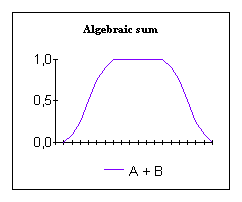T-norms and S-norms
Important set connectives
This page deals with set connectives.For better reading I write for μA(x) (= the grade of membership of x in A): A.
So A is the fuzzy set A.
Now let's take two fuzzy sets A and B.

The minimum operator is the well known operator to model intersection.
It is the red line in the picture below.

This minimum operator is one of the "triangular norms".
With the T-norms there are the T-conorms, also called the S-norms.
They model union. The maximum operator is an S-norm.
It is the blue line in the picture above.
Apart from that I mention the algebraic sum of A and B: A + B

T-norms and S-norms are logical duals and can be computed from each other by:
t(A,B) = 1 - s(1-A, 1-B)
A few well known couples of T-norms and S-norms
| tw sw | Drastic product Drastic sum | tw(A,B) = min (A,B) if max (A,B) = 1, else = 0 sw(A,B) = max (A,B) if min (A,B) = 0, else = 1 |
| t1 s1 | Bounded difference Bounded sum | t1(A,B) = max (0, A + B - 1) s1(A,B) = min (1, A + B) |
| t1.5 s1.5 | Einstein product Einstein sum | t1.5(A,B) = (AB/(2 - [ A + B - AB]) s1.5(A,B) = (A + B)/ (1 + AB) |
| t2 s2 | Algebraic product Probabilistic sum | t2(A,B) = AB s2(A,B) = A + B - AB |
| t2.5 s2.5 | Hamacher product Hamacher sum | t2.5(A,B) = (AB)/(A + B - AB) s2.5(A,B) = (A + B - 2AB)/(1 - AB) |
| t3 s3 | Minimum Maximum | t3(A,B) = min (A,B) s3(A,B) = max (A,B) |
Look here for the diagrams of the T- and S-norms.
They have the following relationship:
tw <= t1 <= t1.5 <= t2 <= t2.5 <= t3 s3 <= s2.5 <= s2 <= s1.5 <= s1 <= sw
Operators that are more general
| Symbole | Name | Formula |
| FAND | Fuzzy AND | FAND(A,B) = γ*min(A,B) + 0.5(1-γ)(A + B) γ Î [0,1] |
| FOR | Fuzzy OR | FOR(A,B) = γ*max(A,B) + 0.5(1-γ)(A + B) γ Î [0,1] |
Even more general are convex combinations of T-norms with their S-norms. For example the convex combination of the minimum and the maximum operator. Or of the algebraic product and the probabilistic sum.
Some convex combinations of T-norms with their S-norms
| Name | Formula |
| Convex combination of min and max | Comb(A,B)= γ*min(A,B)+(1-γ)*max(A,B) γ Î [0,1] |
| Convex combination of algebraic product and probabilistic sum | Comb(A,B)= γ*(AB)+(1- γ)*(A+B-AB) γ Î [0,1] |
This is one of the features of fuzzy logic, that makes it so well suited to handel the vagueness of the real world.
Source: T.Tilly, "FUZZY LOGIC, theorie, praktijk, hard-en software", Kluwer Techniek, ELEKTRO/ELEKTRONICA.